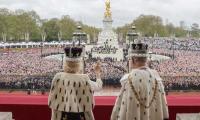The earlier part of this story was carried on the Saturday’s edition. The remaining is being reproduced below:
“The Germans would not get it into their head to erect statues of Hitler and cheer them,” said Mireille-Tsheusi Robert, an activist in Congo who wants Leopold statues removed from Belgian cities. “For us, Leopold has committed a genocide.”
In the US, the May 25 death of Floyd, a black man who died after a white Minneapolis police officer pressed a knee to his neck, has led to an all-out effort to remove symbols of the Confederacy and slavery.
The Navy, the Marines and NASCAR have embraced bans on the display of the Confederate flag, and statues of rebel heroes across the South have been vandalised or taken down, either by protesters or local authorities.
On Wednesday night, protesters pulled down a century-old statue of Confederate President Jefferson Davis in Richmond, Virginia, the former capital of the Confederacy. The 8-foot (2.4-meter) bronze figure had already been targeted for removal by city leaders, but the crowd took matters into its own hands. No immediate arrests were made.
It stood a few blocks away from a towering, 61-foot-high (18.5-meter-high) equestrian statue of Gen. Robert E. Lee, the most revered of all Confederate leaders. Democratic Gov. Ralph Northam last week ordered its removal, but a judge blocked such action for now.
The spokesman for the Virginia division of the Sons of Confederate Veterans, B. Frank Earnest, condemned the toppling of “public works of art” and likened losing the Confederate statues to losing a family member.
Richmond Mayor Levar Stoney, who has proposed dismantling all Confederate statues in the city, asked protesters not to take matters into their own hands for their own safety. But he indicated the Davis statue is gone for good.
“He never deserved to be up on that pedestal,” Stoney said, calling Davis a “racist & traitor.”
Elsewhere around the South, authorities in Alabama got rid of a massive obelisk in Birmingham and a bronze likeness of a Confederate naval officer in Mobile. In Virginia, a slave auction block was removed in Fredericksburg, and protesters in Portsmouth knocked the heads off the statues of four Confederates.
The monument is believed to be located where a slave whipping post once stood, and removing it is a small step in the right direction, Portsmouth activist and organiser Rocky Hines said.
“It’s not a history that we as a nation should necessarily be proud of. For us, the history is a lot of history of slavery and hatred,” he said. “It’s bothered people for a long time.”
In Washington, House Speaker Nancy Pelosi said it is time to remove statues of Confederate figures from the U.S. Capitol and take their names off military bases such as Fort Bragg, Fort Benning and Fort Hood.
President Donald Trump on Wednesday rejected the idea of renaming bases. But Republicans in the Senate, at risk of losing their majority in the November elections, aren’t with Trump on this. A GOP-led Senate panel on Thursday approved a plan to take Confederate names off military installations.
Supporters of Confederate monuments have argued that they are important reminders of history; opponents contend they glorify those who went to war against the US to preserve slavery.
The Davis monument and many others across the South were erected decades after the Civil War during the Jim Crow era, when states imposed tough new segregation laws, and during the Lost Cause movement, in which historians and others sought to recast the South’s rebellion as a noble undertaking, fought to defend not slavery but states’ rights.
For protesters mobilized by Floyd’s death, the targets have ranged far beyond the Confederacy. Statues of Columbus have been toppled or vandalised in cities such as Miami; Richmond; St. Paul, Minnesota; and Boston, where one was decapitated. The city of Camden, New Jersey, removed a statue of Columbus. Protesters have accused the Italian explorer of genocide and exploitation of native peoples.
Scott Sandage, a historian at Carnegie Mellon University, noted that Americans have a long tradition of arguing over monuments and memorials. He recalled the bitter debate over the now-beloved Vietnam Veterans’ Memorial in Washington when the design was unveiled.
“Removing a memorial doesn’t erase history. It makes new history,” Sandage said. “And that’s always happening, no matter whether statues go up, come down, or not.”
Concluded
Khyber Pakhtunkhwa Chief Minister Ali Amin Gandapur. —Radio PakistanISLAMABAD. All the witnesses have been...
Former prime minister, MNA Raja Pervez Ashraf speaking on the occasion of World Press Freedom Day at the National...
Poster of “7th Sky Entertainment” drama serial “Khumar”. — YouTube/Geo News KARACHI: The last episode of...
Mahr Sahibzad Khan. — PMD websiteISLAMABAD: Prime Minister Shehbaz Sharif approved the summary for re-employment of...
Pashtunkhwa Mili Awami Party Chairman Mahmood Khan Achakzai is participating in a protest in Pishin against alleged...
In this screengrab, Agriculture Minister Ashiq Hussain Kirmani chairs a meeting, Punjab Agriculture Secretary Iftikhar...







